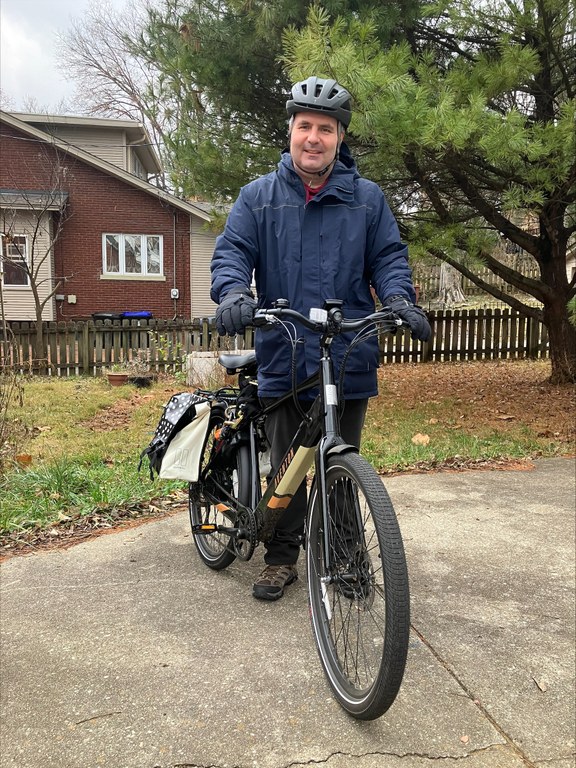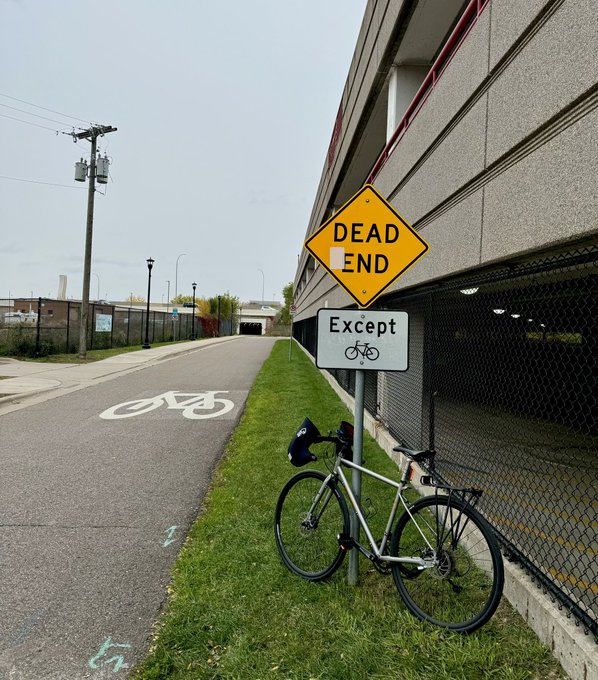Benne's bike commute to campus
By Benne Holwerda, UofL Physics Professor and Sustainable Operations Committee member
 The academic year is in full swing and that means you do see cyclist commute to work and our campuses, especially UofL's main Belknap campus. Cycling tends to be pretty seasonal in Kentucky, but judging from how many cyclist I see around town, it is gaining in popularity (I know this is not a scientifically valid study).
The academic year is in full swing and that means you do see cyclist commute to work and our campuses, especially UofL's main Belknap campus. Cycling tends to be pretty seasonal in Kentucky, but judging from how many cyclist I see around town, it is gaining in popularity (I know this is not a scientifically valid study).
Cycling is an excellent way to get to either campus and I’m here to convince you it needs not be only done by super athletic or crunchy granola types. And it can be just as practical in the cooler months as in the warmer times.
Quick and cheap
Cycling is a great way to get to campus, and with the rise of electric-assist bikes, it's a great option even if you live 12 or 15 miles away. If you live within six miles of campus, cycling is even competitive in door-to-door commuting time, especially if you have to hunt for parking or park far from your ultimate destination.
Cycling eliminates your costs for gas and parking, it builds daily exercise into your routine, and it can even save some time on the commute.
Let’s start with costs. For someone living 12 miles from campus and commuting daily, a faculty member at minimum pays $2,358 in mileage (2x12 miles, 5 days a week, 30 weeks a year, using the IRS 2023 mileage, which includes gas and the wear on your car). Park on campus and it costs you a minimum of $324/year in a blue lot. Conservatively, that means you’d spend at least $2,682 a year to commute.
Now, that’s a lot, but a bike does come with some minor expenses for maintenance and such. Having your bike serviced regularly is just as a good an idea as it is with a car. If you cannot do it yourself, call it a few hundred dollars per year. If you have an electric bike like I do, you will incur some minor expenses in recharging the battery, but it comes down to a laughable amount. Switching from a gas-powered to an electric car can save you money on fuel, but you'll still incur considerable parking, insurance, and maintenance costs that bike commuters don't pay. An electrical bike gets me the same mobility at a much lower starting price and operating cost [3].
Financially this would be a nice win, even for someone who commutes half the distance, or fewer days a year.
On your bike
If you want to try two-wheeled commuting, you’ll need a bike, of course. Maybe you already have one and it’s a matter of digging it out of the garage. Like most things you’re trying to make a habit of, make it easy to get started. So once you've dusted it off, find a spot for your bike that is easy to get to.
Or perhaps you don't have a bike (or a good one for commuting) and it's time to invest in a new or used bike specifically for the commute. There certainly are differences in your needs as a commuter as opposed to, say, a cycling race.
Of course I took it a step further since I planned for a regular, longer-distance commute. I bought an e-bike, which was a bigger investment, for sure, but optimized for longer-distance commuting. It makes short work of Kentucky’s hills, allows me to amp it up when I’m not feeling it (a reverse spin class), and it has built-in lighting bright enough to signal overhead planes in a pinch. I love it. An e-bike is a great compromise between an EV car and doing all the pedaling yourself.
For starters, you'll want to consider how you will transport things as well as yourself on a bike. I strongly advise investing in panniers. Backpacks seem like a reasonable option but honestly overstay their welcome pretty quick. I’m not some super-fit student, and my back hurts some days because I slept weird. Panniers allow you to drop what you need in the cargo area of your bike and not think about it till you get to work. Lunch, work bag etc.
For parking on campus you do need a good lock. I go the Dutch route and have both a horseshoe shaped “cafe lock” through the wheel and a thick, sturdy chain to lock my bike to a rack or street furniture. In the Netherlands, that’s the minimum. Here it’s may be considered overkill, but bike theft is common on campus and e-bikes are not cheap to replace.
Bike helmets are not a fashion accessory and you should get one that fits well. Another key to safe cycling year-round are good bike lights, either mounted on the bike or your helmet. High-visibility clothing is also helpful. A rain jacket and pants or a rain cape and some gloves are part of the kit, as well. Rain doesn't dampen my commute as often in Kentucky as you’d think. But when it does it really comes down and it can be best to wait out the storm, if you can. Or make that really rainy day, the day you choose to take the bus, carpool, or drive to work. Just because you routinely bike, doesn’t mean it’s mandatory.
Safe cycling
Biking into campus is pretty straightforward once you have found a safe, comfortable route. In most cases, your bike route will probably be different than your driving route. There are several busy, high-speed roads going into or past campus (such as Eastern Pkwy, I-64, etc.) and while these make sense for a car commute, they are generally not the best option on a bike. Fortunately, there are plenty of lower-traffic, calmer residential streets surrounding campus that you can make use of. If I do find myself on a busy street, I will occasionally take a sidewalk. Technically, sidewalk-riding is illegal for those over 13, but sometimes it is the safest option. Of course, this decision remains the purview of your own assessment.
The general theme for safety is to give yourself and those in traffic space and time. Not being overly rushed and allowing the cars go first (and out of your way) is key. I find that Kentucky drivers, by and large, are polite and considerate, if intermittent users of the turn signal. However, because there are still too few of us on the road, drivers often simply didn’t expect or see cyclists. Though it helps to make yourself easy to spot with light-colored clothing, reflectors, and lights, it is best to assume drivers won't notice you unless you are directly in front of them.
I’ve already put 500miles on this new bike, almost all of it commuting to UofL. I like it. Let’s see if I can keep this up for the rest of the year.
Read More: 280 million e-bikes are slashing oil demand far more than electric vehicles: E-bikes and scooters displace 4x as much demand for oil as all of the EVs in the world (The Conversation, Nov. 18, 2023)
Photo credit: Laura Mitchell, who says, "This looks like the cover for a book about bikes and climate change."




